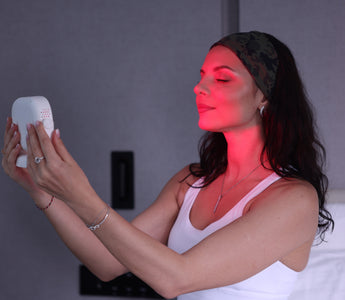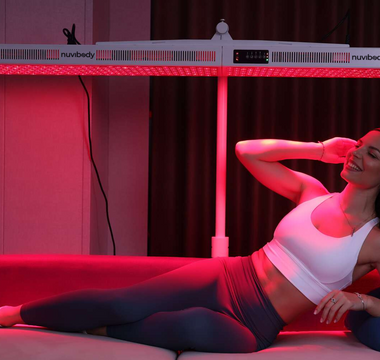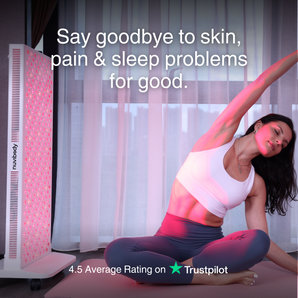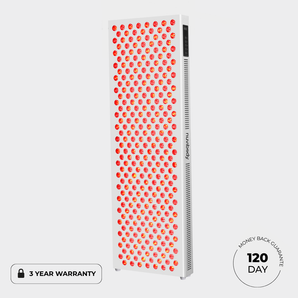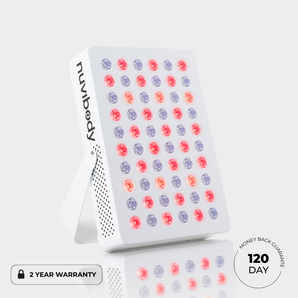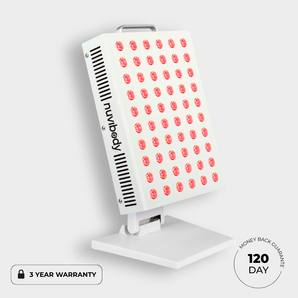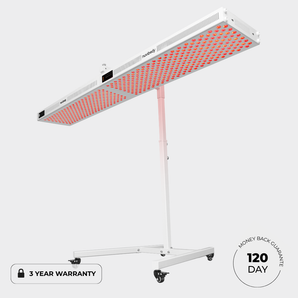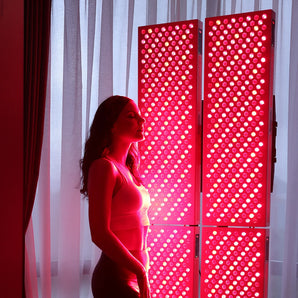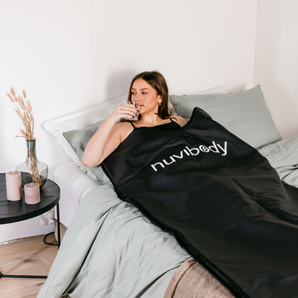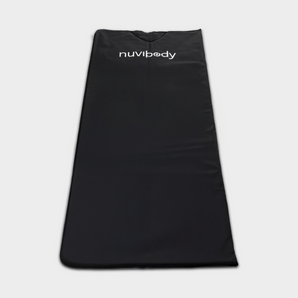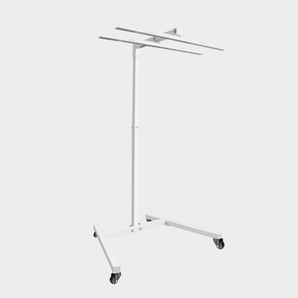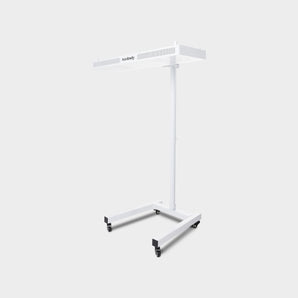Acne is one of the most common skin conditions worldwide, and many people are looking for effective ways to treat it. From prescription medications to skin care products, there are a wide range of options. But what if there was a natural, non-invasive treatment that could help reduce acne and improve your skin? Red light therapy is gaining popularity as a potential solution. But how effective is it against acne and pimples? We take a closer look at the science behind red light therapy and tell you if and how it can help improve your skin.
How does red light therapy work for acne?
Red light therapy uses specific wavelengths of light (usually between 630-850 nm) to stimulate various physiological processes in the body. The primary effect of red light therapy is the activation of mitochondria in the cells, resulting in increased production of energy (ATP). This promotes cell regeneration and helps repair damaged tissue. But how can this specifically help treat acne?
Acne often involves inflammation in the skin, which leads to the formation of pimples and other skin problems. Red light therapy can reduce inflammation by increasing blood flow and speeding up the healing process. It can also help reduce the production of sebum (skin oil), a major factor in the formation of acne. By calming the skin and speeding up recovery, red light therapy can be a valuable addition to your skin care routine.
Scientific evidence for red light therapy for acne
There is growing scientific evidence to support the effectiveness of red light therapy for acne. Several clinical studies have shown that red light therapy can help reduce acne lesions and improve overall skin condition. A study published in Dermatologic Surgery showed that red light therapy can lead to a significant reduction in acne-related inflammation and pimples, especially in moderate to severe acne ( source ).
The mechanisms behind these effects are still under investigation, but researchers suggest that red light therapy can reduce inflammatory responses in the skin, leading to faster healing of acne lesions. In addition, it can regulate the activity of the sebaceous glands, which is a major factor in the development of acne.
What is the optimal dosage for red light therapy for acne?
The effectiveness of red light therapy depends greatly on the correct dosage . This includes the wavelength of the light, the intensity, the duration of the treatment and the frequency. For acne, a wavelength of 630-660 nm is often recommended, because this range penetrates the skin best and has anti-inflammatory effects .
In terms of treatment time, most studies vary between 5 and 20 minutes per session. The frequency of treatments is usually recommended at 3 to 5 times per week, depending on the severity of the acne. It is important to be consistent in your treatments to achieve the best results.
While some devices may require fewer sessions to see results, it is important to note that red light therapy often takes time to reach its full effect. Most users notice improvement after a few weeks of regular use.
Why should you consider red light therapy for acne?
There are several reasons why you might consider red light therapy as part of your acne treatment plan:
- Natural and Non-Invasive : Unlike some medications or topical treatments, red light therapy uses natural light to repair the skin. It offers a safe and effective way to treat acne without the side effects often associated with pharmaceutical treatments.
- Less Inflammation : Acne is often accompanied by inflammation, and red light therapy has been shown to reduce inflammation. This not only helps treat existing breakouts, but can also help prevent new ones from occurring.
- Improves skin texture : In addition to reducing acne, red light therapy can also help improve the overall texture of your skin. It promotes collagen production, which can help reduce scarring left behind after acne breakouts.
- Little to No Side Effects : Red light therapy has very few side effects and is a safe option for those looking for a natural alternative to more aggressive treatments.
How do you use red light therapy for acne?
To get the most out of your red light therapy for acne, it’s important to be consistent and use the right devices. For example, you might want to opt for a powerful red light therapy device like the Nuvibody lamps , which are specifically designed to deliver the right wavelengths and intensity for optimal results.

When using red light therapy at home, make sure to hold the device at an appropriate distance from your face (usually between 10 and 30 cm). Aim the light at the affected areas for the recommended amount of time and be patient. Although you will see improvement after a few sessions, consistent use is the key to long-lasting results.
Is red light therapy suitable for everyone with acne?
While red light therapy shows promise for treating acne, it’s important to know that not everyone will experience the same results. Some people with severe forms of acne, such as cystic acne, may benefit from additional treatments, such as medications or professional dermatological treatments.
When in doubt, it is always advisable to consult a dermatologist before trying new treatments, especially if you are already undergoing other skin treatments.
Conclusion: An effective and natural approach to acne
Red light therapy offers a natural, safe, and scientifically backed way to treat acne and improve overall skin health. By reducing inflammation, regulating sebum production, and repairing the skin, it can help reduce acne lesions and improve skin texture. If you’re looking for an effective way to tackle acne, using a high-quality red light therapy lamp can be a valuable addition to your skincare routine.
Want to experience the benefits of red light therapy for yourself? Opt for a powerful device from Nuvibody , designed to deliver the optimal wavelengths and intensity for the best results. Get started today and discover how red light therapy can help improve your skin!
Frequently Asked Questions
1. What is red light therapy and how does it work for acne?
Red light therapy uses specific wavelengths of light (between 630-850 nm) to heal the skin and reduce inflammation. It stimulates the mitochondria in the cells, which produces more energy (ATP). This speeds up the repair of damaged skin cells, reduces inflammation and regulates sebum production, which helps to reduce acne.
2. Is red light therapy effective for treating acne?
Yes, multiple clinical studies support the effectiveness of red light therapy in treating acne. It has been shown to reduce inflammation, lighten blemishes and improve overall skin condition.
3. How long does it take before I see results from red light therapy for acne?
Most people see noticeable improvement after a few weeks of consistent use. It is important to treat regularly (usually 3-5 times per week) to achieve the full effect. Results may vary depending on the severity of the acne and the frequency of treatment.
4. How many minutes should I use red light therapy for acne?
Most studies recommend a session of 5 to 20 minutes per treatment. This can vary depending on the severity of the acne and the device used. Consistency is key: treating regularly will help you achieve the best results.
5. Which wavelength of light is best for acne?
For acne, a wavelength between 630 and 660 nm is generally recommended. This range penetrates the skin well and has anti-inflammatory effects that help treat acne lesions.
6. What are the benefits of red light therapy besides acne treatment?
Red light therapy has multiple benefits, including promoting overall skin health, improving skin texture, and reducing acne scars. It can also help regulate sebum production and improve blood circulation.
7. Does red light therapy have side effects?
Red light therapy generally has few side effects. The treatment is non-invasive and uses natural light to repair the skin. It is a safe option for many people, even those who are sensitive to other skin treatments.
8. Is red light therapy suitable for everyone with acne?
While red light therapy is effective for many people, results can vary. People with severe acne, such as cystic acne, may benefit from additional treatments. It is always a good idea to consult a dermatologist if you are unsure about the suitability of this therapy for your skin.
9. How can I use red light therapy at home for acne?
You can use a red light therapy device that is specifically designed for acne treatment. Hold the device 10-30 cm away from your skin and treat the affected areas for the recommended time (usually 5-20 minutes). Consistency is key for best results.
1 0 . Are Nuvibody devices suitable for home use for acne treatment?
Yes, the Nuvibody devices are designed for both professional and home use and deliver the right wavelength and intensity for effective acne treatment. They are easy to use, safe and offer the possibility to undergo a treatment at the comfort of your own home.


